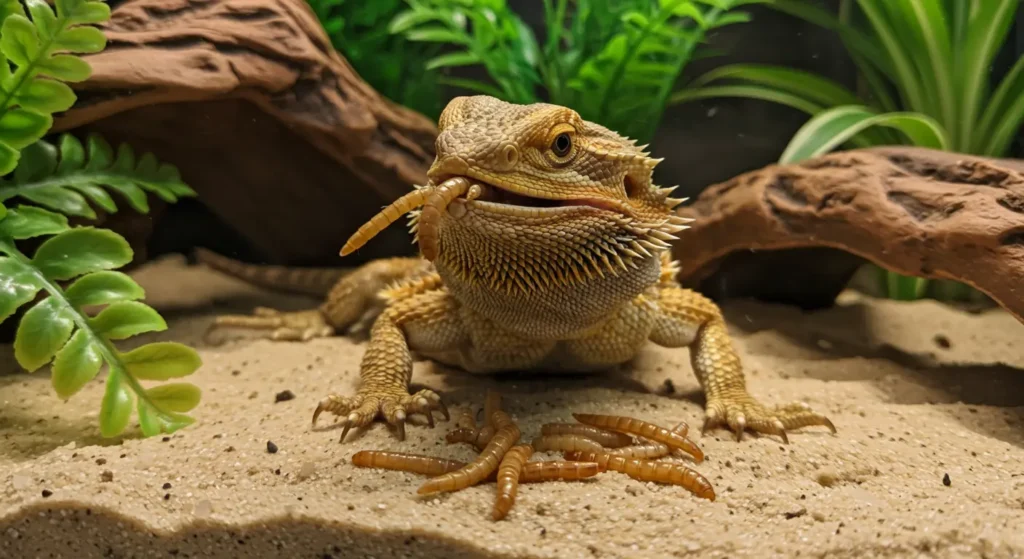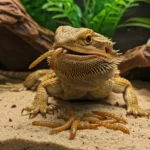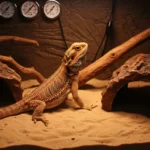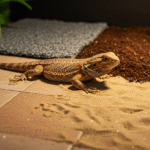Can Bearded Dragons Eat Worms? Many reptile owners ask this when choosing treats for their pet. Worms are easy to find in pet stores, and they seem like a fun snack—but Can Bearded Dragons Eat Worms without risks?
The truth is, not all worms are the same. Some offer protein and moisture, while others are too fatty or hard to digest. Feeding the wrong type, or offering worms too often, can lead to health problems.
That’s why it’s important to know what worms bearded dragons can eat, how often to feed them, and which kinds to avoid. With the right knowledge, you can offer worms safely and even boost your dragon’s nutrition.
This guide will walk you through everything you need to know—clearly, confidently, and with expert care. Let’s get started.
Can Bearded Dragons Eat Worms? The Complete Breakdown
Many bearded dragon owners ask, can bearded dragons eat worms safely? The answer is yes—but only when you choose the right types and offer them in moderation. Worms vary in nutritional value, digestibility, and fat content. Understanding the benefits and risks can help you create a balanced feeding plan that supports your dragon’s long-term health.
Are Worms Safe for Bearded Dragons to Eat?
Worms are generally safe for bearded dragons, but only if you choose the right kind. Not all worms are equally digestible or nutritious. Young dragons, in particular, should avoid hard-shelled worms like mealworms, which can cause impaction. Choose soft-bodied options such as hornworms or black soldier fly larvae to reduce digestive risks. Always avoid wild-caught worms, as they may carry parasites, pesticides, or harmful bacteria. Stick to feeder worms bred specifically for reptiles. You should also remove uneaten worms from the enclosure to prevent them from biting your dragon. Feeding worms responsibly means considering type, size, and frequency. When offered under proper conditions, worms can be a healthy and safe treat for your bearded dragon.
Benefits of Feeding Worms to Your Bearded Dragon
Feeder worms provide both nutritional and behavioral benefits. Most are high in protein, supporting muscle development and energy levels, especially in growing juveniles. Some, like hornworms, also offer hydration, which helps in arid environments. Live worms trigger natural hunting instincts, encouraging physical activity and mental engagement. This type of stimulation can lead to a healthier and more alert dragon. Offering a variety of worms also adds excitement to your pet’s diet. However, balance is crucial. Over-relying on worms can shift their focus away from healthier staples like greens and vegetables. When fed in moderation, worms are a rewarding and useful part of a bearded dragon’s routine.
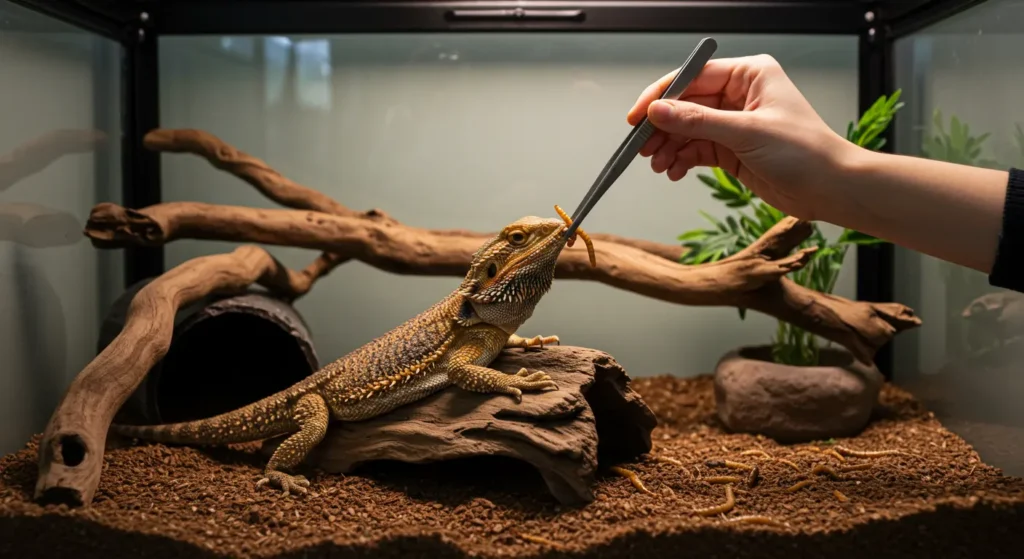
When Worms Become a Problem: Potential Risks
Worms may seem harmless, but problems can arise when they’re overfed or misused. High-fat worms like waxworms and butterworms can cause obesity, especially in adults with low activity levels. Worms with hard exoskeletons, such as mealworms, may lead to impaction—especially in younger dragons. Feeding too many worms without calcium supplementation increases the risk of metabolic bone disease. Dragons can also develop picky eating habits, preferring fatty worms over healthier insects and greens. This reduces the overall balance of their diet. Always rotate worm types and limit portion sizes. Monitor your dragon’s weight, behavior, and digestion to avoid these risks. Responsible feeding helps prevent health issues and supports long-term wellness.
How Often Should You Feed Worms?
Feeding frequency depends on your dragon’s age and dietary needs. Adults should only receive worms two to three times a week. These treats should never become a daily staple. Juveniles need more protein and can have worms more often, but they still require variety. Rotate worm feedings with other insects like crickets or Dubia roaches. Offering too many worms can reduce appetite for vegetables and calcium-rich food. Give only a few worms per feeding session to prevent overfeeding. Monitor your dragon’s response and adjust as needed. A balanced schedule with moderate worm use ensures a healthy, diverse diet.
Different Types of Worms Bearded Dragons Can Eat
Bearded dragons can eat a variety of worms, but not all are equally beneficial. Some are nutritious and easy to digest, while others are high in fat or pose a digestion risk. Choosing the right worm depends on your dragon’s age, health, and dietary needs. Understanding the differences between common feeder worms helps you make safer, more nutritious choices.
Mealworms: Popular, But Are They Ideal?
Mealworms are widely available, but they come with some drawbacks. Their tough outer shell makes them hard to digest, especially for hatchlings or small juveniles. This can increase the risk of impaction. Nutritionally, mealworms are higher in fat and lower in calcium compared to other options. They can be used sparingly for adult dragons but should never be a staple. Always dust mealworms with calcium and gut-load them before feeding. Look for active, healthy worms to avoid feeding anything that may be diseased or spoiled. Better alternatives like black soldier fly larvae or hornworms offer more nutritional value. While mealworms are convenient, they should only play a small role in your dragon’s feeding routine.
Superworms vs Waxworms: What’s the Difference?
Superworms and waxworms both serve as treats, but their nutritional profiles are very different. Superworms are more active and provide moderate protein, with softer shells than mealworms. They’re easier to digest and great for adult dragons when offered in small amounts. Waxworms are soft-bodied but extremely high in fat. They’re useful for underweight or picky eaters but should not be a regular part of the diet. Feeding too many waxworms can lead to obesity and poor appetite for healthier foods. Use waxworms as occasional treats only. Superworms, while slightly better, should still be rotated with more nutritious feeders. Understanding these differences helps you create a smarter feeding plan.
Hornworms and Butterworms: Are They Worth It?
Hornworms are a great choice for many bearded dragons. They’re rich in moisture, low in fat, and very easy to digest. Their soft bodies make them ideal for dragons of all ages. Butterworms are also soft and appealing, but they contain more fat. These are best reserved for occasional use or for dragons that need to gain weight. Both options can be pricey, so most owners use them as special additions rather than staples. Hornworms can be fed more frequently—up to three times a week—while butterworms should be used less often. Always monitor your dragon’s weight and behavior. If used properly, these worms add nutrition, hydration, and variety to your dragon’s diet.
Black Soldier Fly Larvae: A Hidden Gem
Black soldier fly larvae are among the best feeder insects you can offer. They’re high in natural calcium, which supports strong bones and helps prevent metabolic bone disease. These larvae don’t need dusting with supplements, making them convenient and reliable. Their soft bodies are easy to digest, even for young dragons. With a great protein-to-fat ratio, they can be offered more frequently than fattier worms. Some dragons may take time to accept them, but most learn to enjoy them quickly. They’re also clean, odor-free, and easy to store. Use them regularly as part of a balanced diet. If you’re looking for a nutrient-rich worm that fits into both juvenile and adult diets, black soldier fly larvae are an excellent choice.
Nutritional Value of Worms for Bearded Dragons
Not all worms are created equal when it comes to nutrition. To feed your bearded dragon well, you need to understand how worms compare in terms of protein, fat, and calcium. Making smart choices ensures your pet gets both variety and balanced nutrition.
Protein, Fat, and Calcium Levels Compared
Worms vary greatly in nutritional content. Hornworms are low in fat and high in moisture, making them excellent for hydration but not as rich in protein. Superworms contain more protein but also carry a moderate fat level. Waxworms and butterworms are especially high in fat, which can cause weight gain if fed too often. Black soldier fly larvae stand out due to their naturally high calcium levels and balanced fat-to-protein ratio. This makes them ideal for frequent use. Comparing these levels helps you understand which worms work best as treats and which can be fed more regularly. Always consider both the nutrients provided and your dragon’s individual needs before choosing a feeder insect.
Worms vs Other Insects: Crickets and Dubia Roaches
Crickets and Dubia roaches are often recommended as staple feeders due to their high protein content and low fat. Unlike some worm species, they also encourage more movement during feeding, which can stimulate a dragon’s hunting behavior. However, worms are generally easier to digest and less likely to escape or hide in the enclosure. While crickets can be noisy and harder to store, worms are more manageable for many owners. Each has pros and cons, but combining them offers a better range of nutrients and keeps feeding times varied and engaging. Rotating between worms and insects gives your dragon the best of both worlds.
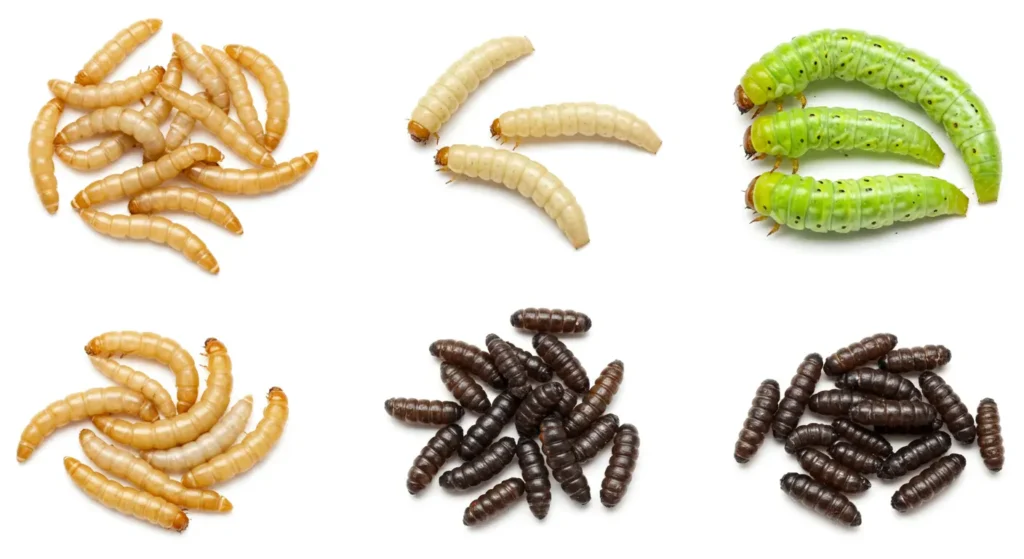
The Importance of Gut-Loading Feeder Insects
Gut-loading refers to feeding your worms or insects nutrient-rich foods 24 hours before offering them to your dragon. This practice increases the overall nutritional value of each feeder. Even the healthiest worm can lack key vitamins or minerals if it’s not gut-loaded. Leafy greens, carrots, and commercial gut-load formulas are excellent options. For example, black soldier fly larvae may not need gut-loading for calcium, but still benefit from a vitamin boost. Crickets and roaches absolutely need gut-loading to be effective. This small step makes a big difference in your dragon’s nutrient intake, especially for vitamins A and E.
Vitamin D3 and Calcium Balance: Avoiding Metabolic Bone Disease
Metabolic bone disease (MBD) is one of the most common yet preventable health issues in bearded dragons. It often occurs due to an imbalance between calcium and vitamin D3. Feeder worms like waxworms and butterworms are low in calcium and can contribute to deficiencies if fed often. In contrast, black soldier fly larvae naturally contain high calcium levels, which support bone health. Still, calcium alone isn’t enough. Your dragon also needs proper UVB lighting to metabolize vitamin D3. Dusting worms with calcium powder (with or without D3, depending on lighting) adds another layer of protection. Balancing these nutrients keeps bones strong and prevents serious illness.
Expert Tips to Make Worm Treats Healthier and More Effective
Feeding worms offers many benefits, but you can improve their value with a few expert strategies. Combining worms with other foods and handling them correctly maximizes nutrition and safety. These tips will help you create a balanced, enjoyable feeding routine for your bearded dragon.
Mix Worms with Greens for Balanced Nutrition
Pairing worms with leafy greens is a simple way to balance your dragon’s diet. Worms provide protein and fat, but they lack essential vitamins and fiber found in vegetables. Offering greens alongside worm treats encourages better digestion and nutrient absorption. Dark, calcium-rich greens like collard, mustard, or dandelion leaves are excellent choices. You can chop the greens or even hide worms in the foliage to encourage natural foraging behavior. This mix prevents nutrient gaps and keeps your dragon interested in a varied diet. Avoid feeding worms as the sole meal to maintain overall health.
How to Encourage a Picky Dragon to Eat Worms
Some dragons can be selective and refuse new foods like worms. Start by offering small amounts mixed with familiar favorites. Using live, moving worms can spark their hunting instincts and curiosity. Warming the worms slightly before feeding also makes them more appealing. You can try hand-feeding or placing worms near your dragon’s usual feeding spots to encourage acceptance. Patience is key—introduce worms gradually and consistently. Avoid forcing food, as stress can harm appetite. With time and gentle encouragement, even picky dragons often learn to enjoy worms.
Storing and Handling Worms Properly
Proper storage and handling ensure worms stay healthy and safe for feeding. Keep live worms in a cool, dry place with adequate ventilation to prevent mold or death. Use clean containers with substrate like oats or bran. Avoid overcrowding to reduce stress and cannibalism among worms. Gut-load worms daily with nutritious food to maximize their value. When handling worms, wash your hands before and after to prevent contamination. Discard dead or unhealthy worms promptly. Proper care maintains worm quality, protecting your dragon from illness and ensuring consistent nutrition.
Signs of Overfeeding and Digestive Stress
Bearded dragons may show subtle signs if you feed worms too often or in large amounts. Watch for bloating, constipation, or irregular stools, which suggest digestive problems. A sluggish or lethargic dragon may also indicate overfeeding or poor diet balance. Loss of appetite or refusal to eat vegetables can be another warning. Weight gain beyond healthy levels is a common sign of excessive fatty treats. If you notice these symptoms, reduce worm feedings and increase greens and fiber. Consulting a reptile vet for persistent issues is always recommended. Early detection helps prevent serious health complications.
Conclusion
Feeding worms to your bearded dragon can be a great way to enhance their diet and provide enrichment—when done correctly. Understanding can bearded dragons eat worms safely involves choosing the right types, offering balanced nutrition, and controlling feeding frequency. Worms like black soldier fly larvae and hornworms offer excellent nutrients and hydration, while fatty options such as waxworms should be reserved as occasional treats. Always prioritize variety by mixing worms with leafy greens and other insects to ensure your dragon receives a well-rounded diet.
By following expert feeding tips and monitoring your pet’s health closely, you can safely include worms as part of your bearded dragon’s treat time. This approach helps prevent common risks such as impaction, obesity, and metabolic bone disease. Remember, moderation and careful selection make all the difference. With the right knowledge and care, feeding worms can truly make treat time better—for both you and your scaly friend.

